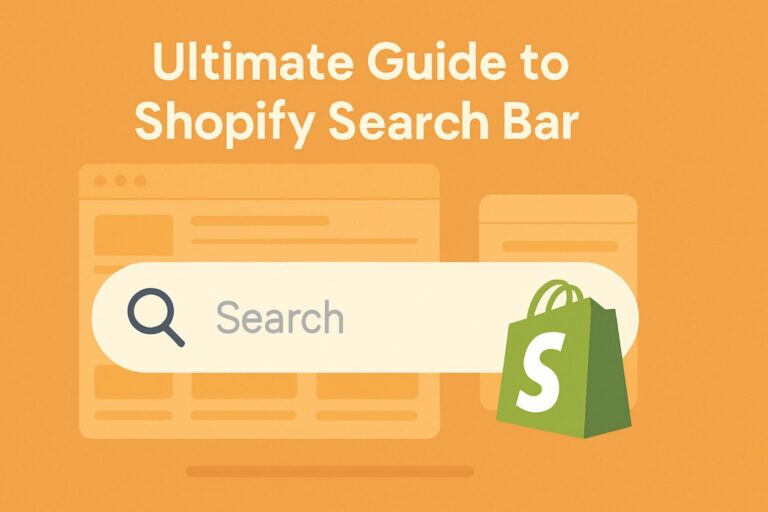1. Introduction to Shopify Search Engine Optimization
What is Search Engine Optimization on Shopify?
Shopify Search Engine Optimization (SEO) doesn’t just refer to Google rankings. It also includes optimizing your internal on-site search so customers can easily find what they’re looking for. An efficient search engine on your Shopify store ensures users get accurate, relevant, and fast product results.
Why Internal Search Matters
Visitors who use internal search are up to 3x more likely to convert. These are high-intent users already deep in the funnel. A well-optimized Shopify search can significantly reduce bounce rates and increase average order value.
2. Understanding Shopify’s Built-in Search Engine
How Shopify Search Works
Shopify’s default search indexes product titles, descriptions, variants, and tags. It supports basic keyword matching and can show products, blog articles, and pages in the results.
Limitations and Opportunities
- No native fuzzy search or typo tolerance.
- Lacks AI or intent-based results.
- No personalization or ranking flexibility without apps.
3. Benefits of Optimizing Shopify’s Search
- Improved User Experience: Quick, accurate product access.
- Increased Revenue: More product discoveries lead to more purchases.
- Data Insights: Internal search data reveals what your customers really want.
4. Keyword Optimization for Product Listings
Researching E-commerce Keywords
Use tools like Ubersuggest, Ahrefs, or Google Keyword Planner to identify high-intent search terms.
Adding Keywords in Titles, Tags & Descriptions
- Include primary keywords in product titles.
- Use secondary and long-tail keywords in descriptions and tags.
- Avoid keyword stuffing; write naturally.
5. Structuring Content for Search Relevance
- Clear Product Titles: Avoid jargon. Be specific (e.g., “Organic Cotton Men’s T-Shirt – Black”).
- Detailed Product Descriptions: Include dimensions, materials, and uses.
- Alt Text for Images: Describe images with keywords to improve discoverability.
6. Using Shopify’s Search & Discovery App
Features Overview
This app enhances filtering, sorting, and search customization.
How to Install and Customize
- Go to the Shopify App Store.
- Install the Search & Discovery app.
- Customize filters, display order, and synonyms.
7. Enhancing Search with Synonyms & Tags
- Creating Synonym Lists: E.g., “sneakers” = “trainers.”
- Strategic Use of Product Tags: Add variations and alternate spellings.
8. Optimizing Search Filters and Navigation
- Enable faceted search with filters for price, size, color, etc.
- Ensure your collections and categories are properly structured and intuitive.
9. Enabling Predictive and Instant Search
Autocomplete and Suggestions
Predictive search reduces typing and helps shoppers get to products faster.
Tools to Implement Smart Search
Use apps like:
- Expertrec
- Searchanise
- Doofinder
10. Customizing Search Results Pages
- Boost Best Sellers: Place them at the top of results.
- Hide Out-of-Stock Items: Prevent frustration by filtering these out automatically.
11. Leveraging Third-Party Search Apps
Popular Alternatives
- Expertrec
- Algolia
- Searchanise
Integration Steps
- Sign up and index your site.
- Embed the JavaScript code.
- Customize layout and filters.
12. Monitoring Search Performance
- Use Shopify Analytics to monitor search terms and no-result queries.
- Add Google Analytics to track user behavior from search to checkout.
13. A/B Testing Your Search Features
What to Test
- Autocomplete ON vs OFF
- Filter layouts
- Result ranking algorithms
Tools for A/B Testing in Shopify
- Google Optimize
- Convert.com
14. Mobile Optimization for Search
- Ensure your search bar is visible and easy to use on mobile.
- Use large, tappable filters and voice search support.
15. Technical SEO for Internal Search
- Crawlability of Search Pages: Prevent search URLs from being indexed via robots.txt.
- Handling URL Parameters: Use canonical URLs to avoid duplication.
16. Advanced Tactics with AI and Voice Search
- Enable AI-based search through Expertrec or Algolia for smarter results.
- Add voice search support for accessibility and mobile users.
17. Common Shopify Search Optimization Mistakes
- Overstuffing Keywords: Makes search results less relevant.
- Ignoring Analytics: You can’t optimize what you don’t track.
- Not Updating Filters: As your catalog grows, your search structure should too.
FAQs
Use the Search & Discovery app and include relevant product tags, synonyms, and clear titles.
Not always. Many third-party search apps offer drag-and-drop tools or simple embed codes.
No, most apps like Expertrec or Searchanise load asynchronously without affecting speed.
Yes, use Shopify’s analytics or connect Google Analytics with on-site search tracking enabled.
Not natively, but some third-party apps like Expertrec offer it.
Only if you’re allowing pre-orders. Otherwise, it’s better to hide or push them to the bottom.
Conclusion
Optimizing your Shopify search engine is not just a technical enhancement it’s a strategic move to drive better user engagement, improve sales, and gain insights. From simple tweaks like tagging and autocomplete to powerful tools like Expertrec, every step counts. Don’t leave conversions on the table. Optimize your store’s search today and watch your KPIs climb.




